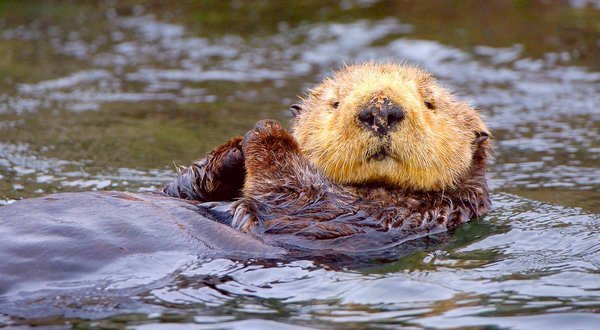Pacific sea otters’ failure to thrive confounds wildlife sleuths
By INGFEI CHEN
27 February 2012 MONTEREY, California – On a fog-shrouded morning in Monterey Bay, wildlife researchers are out to capture a southern sea otter named Blanca — part of a three-year project to learn why her species, hunted to near extinction a century ago, is still in trouble here despite decades of efforts to bring it back. […] About 8:30 a.m., she begins diving for crabs in a kelp bed off Cannery Row. In a skiff on the bay, three otter biologists — Tim Tinker, Brian Hatfield and Joe Tomoleoni — wait for her to stop feeding and take a nap. And wait. And wait. When Blanca finally dozes, five hours after the tracking began, Mr. Hatfield and Mr. Tomoleoni slip into the water 270 yards away, with scuba gear and underwater scooters rigged with nets. Long minutes pass. Then Dr. Tinker, watching with binoculars from the boat, sees her awaken and plunge beneath the surface. “She just saw you,” he tells his companions by radio. “Target is gone. It’s over.” For the wildlife biologists, a clear explanation for the sea otters’ failure to thrive is proving just as elusive. Almost wiped out by fur traders, the species rebounded after an international ban on commercial otter hunting in 1911. But today, the otter population in California is just 2,700, in a mosaic of small, separate colonies off the coast, down from perhaps as many as 16,000 in the past. Multiple factors are stalling the recovery. One popular view, supported by veterinary pathologists who study dead otters, primarily blames coastal pollution — in the form of parasites, bacteria, toxins, and chemicals. But Dr. Tinker and other biologists say that, at least in the areas where the sea otter population is highest, off Monterey and nearby Big Sur, the underlying problem is simply that the otters are running out of food. While they are not starving to death, they are depleting their favorite prey, sea urchins and abalone, and having to spend more time hunting. Poor nutrition is compromising their fitness to survive diseases or other threats, said Dr. Tinker, who runs the United States Geological Survey’s otter research program. “They’re not getting enough food to make it through.” Reports from Dr. Tinker’s team also suggest that otters are particularly vulnerable to sharks. […] The broader project is investigating why some colonies in southeastern Alaska, British Columbia and Washington that were growing rapidly two decades ago — by 20 percent a year — have seen that rate slowed by half, said its leader, James L. Bodkin of the Geological Survey’s Alaska Science Center. The California otters’ growth rate is even more lackluster: usually less than 5 percent a year and, lately, near zero. Sea otters are remarkably voracious: To survive frigid waters, they must fuel a high metabolism by consuming 25 to 30 percent of their body weight every day. Veterinary scientists, who tend to favor the coastal-pollution explanation, note that the otters dine on many types of shellfish and invertebrates that are prone to accumulating contaminants. As a result, the animals “are getting hit with so many things,” said Melissa A. Miller, a veterinary pathologist at the California Fish and Game Department who autopsies stranded otters. “I picture it sometimes almost like otters are sitting there right at that land-sea interface with their mouths open.” In 2010, Dr. Miller and her associates reported evidence that microcystin, a toxin from blue-green algae that live only in freshwater lakes and streams, had killed at least 21 sea otters. Another toxin, domoic acid, is also deadly to the animals. Such poisons are generated by harmful growths of algae that can be fed by fertilizers in agricultural runoff. Dr. David Jessup, a veterinarian retired from the state wildlife agency, says other leading killers include disease-causing parasites transmitted in feces from cats and opossums; infections by bacteria in human or animal feces; and industrial pollutants, which may subtly affect otter immune defenses. These factors all “have some connection to human activities,” he said. But to ecologists, emerging evidence instead strongly suggests that elevated rates of infectious diseases are mostly a symptom of a larger problem — insufficient food resources and malnutrition. “When animals reach a point of extreme nutritional stress,” Dr. Tinker said, “they will succumb to whatever particular stressor they encounter first” — whether a parasite or toxin, a boat strike or a shark attack that a well-fed otter might otherwise fend off or evade. Even without harmful pathogens from land, “I think they would be dying from something else,” said James Estes, a marine ecologist at the University of California, Santa Cruz. […]
Pacific Sea Otters’ Failure to Thrive Confounds Wildlife Sleuths via Wit’s End
